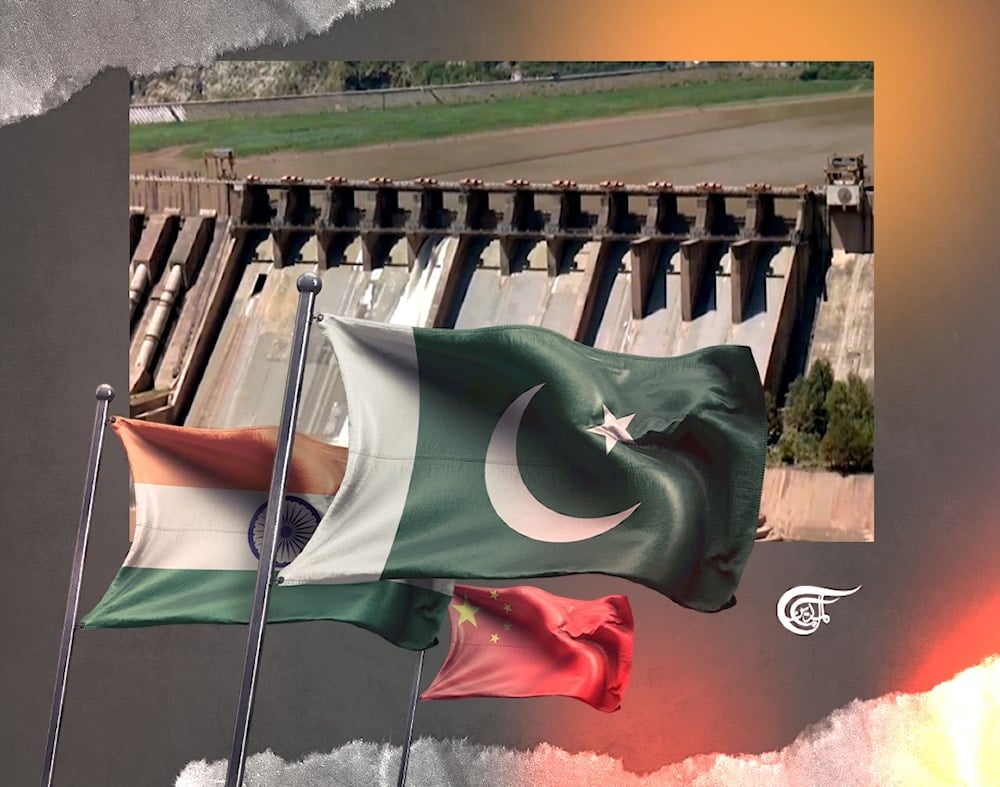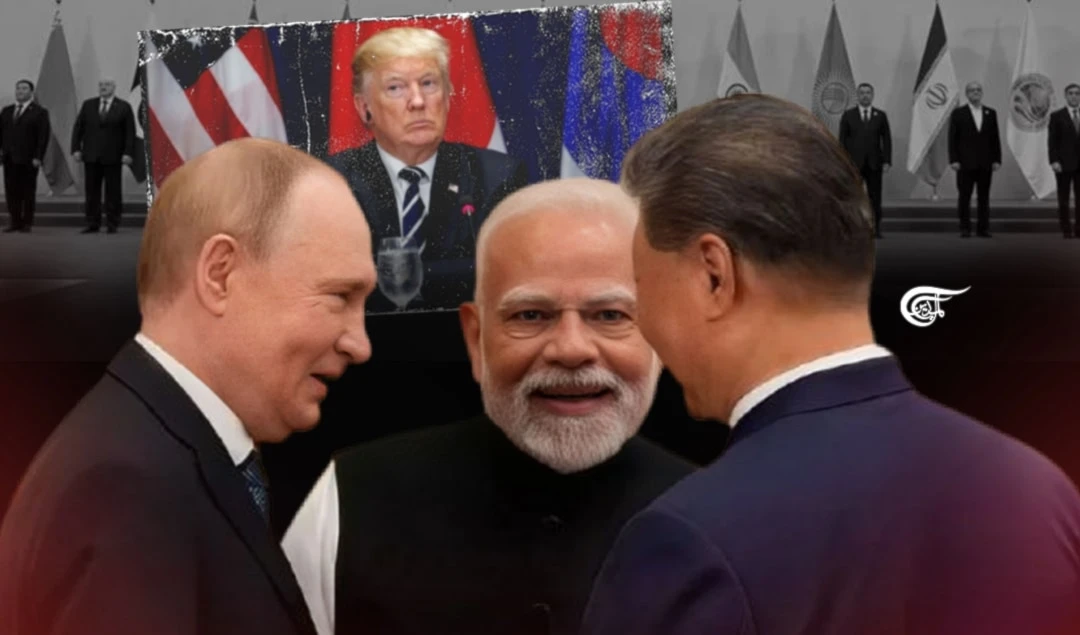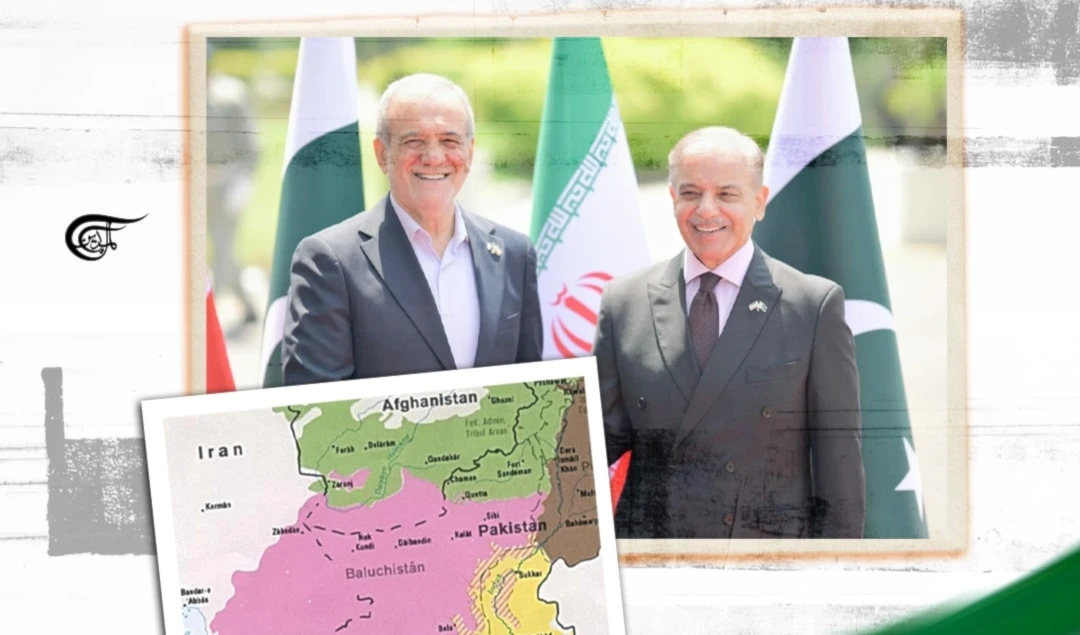Does South Asia head toward a water war following the suspension of IWT by India?
India's decision to halt the International Water Treaty (IWT) following the Pahalgam attack is a risky action that significantly alters the climate security landscape in South Asia.
-

Is Pakistan going to find itself in a dry spell in the coming years (Illustrated by Ali al-Hadi Shmeiss; Al Mayadeen English)
Is Pakistan going to find itself in a dry spell in the coming years, with India threatening to turn off the tap on the Indus River after putting the Indus Water Treaty (IWT) on ice? Pakistan's water supply from both the eastern and western channels is in jeopardy, particularly as Afghanistan is preparing to commence construction on a dam along the Kunar River in its eastern region.
A looming environmental and water disaster in South Asia could spark a regional water conflict shortly, if India and Afghanistan continue to pursue their water weaponization drive. Speaking in the Senate of Pakistan’s debate on the water crisis last week, the Tehreek-e-Insaf Senator, Syed Ali Zafar, claimed that Pakistan was on the brink of disaster. "If we do not solve the water crisis, we will be starved to death, as 90% of our crops depend on the Indus. We have been hit by a water bomb. The urgency of the water war is undeniable,” he said.
What does India plan to do with the water treaty?
In 1960, India and Pakistan formalized the Indus Waters Treaty (IWT) in Karachi, with the backing of the World Bank. The treaty designated the three eastern rivers of the Indus basin—the Ravi, Beas, and Sutlej—for India, while Pakistan received 80% of the three western rivers—the Indus, Jhelum, and Chenab.
In the face of significant divisions and hostility, the treaty endured through two wars between the nuclear adversaries, emerging as a notable case of effective transboundary water management.
In the wake of a terrorist attack in Indian-administered Kashmir, India took the significant step of suspending the IWT with Pakistan on April 23, 2025. National security concerns and allegations of Pakistan's support for cross-border terrorism, which Pakistan strongly denied, prompted the implementation of the suspension. The 1960 treaty, which regulates the distribution of waters from the Indus River and its tributaries, cannot be unilaterally abrogated or suspended by either party involved, according to the treaty's provisions.
India has implemented the suspension as part of a series of measures against Pakistan, which it accuses of supporting cross-border terrorism, a claim that Islamabad categorically rejects. The response includes reciprocal measures directed toward New Delhi, with officials stating that halting the water supply "will be considered an act of war."
On its part, India began building dams and storage to divert the Indus water from flowing toward the west end. However, it is a lengthy process that may take a long time to materialize. India is more inclined to take instantaneous steps, including blocking and letting the water flush out toward Pakistan, resulting in floods in the Pakistani rivers and their tributaries.
Suspension of IWT- A risky step
India's decision to halt the International Water Treaty (IWT) following the Pahalgam attack is a risky action that significantly alters the climate security landscape in South Asia.
South Asia, a bustling hub for more than a quarter of the globe's populace, finds itself in a bit of a pickle when it comes to climate challenges. With its densely populated coastlines, heavily dependent agriculture on the monsoon, and cities submerged under heavy monsoon rain, the region is already experiencing the heat from climate shocks.
A World Bank blog evaluates that the swift melting of glaciers in the Himalayas poses significant risks to water, food, and energy security for several nations in the area. Simultaneously, the region faces intense and recurring heatwaves, which have emerged as a defining feature of its climate challenges, as India and Pakistan continue to record unprecedented temperatures. Bangladesh, characterized by its low-lying delta regions, confronts significant existential threats posed by rising sea levels.
The Indus River system has been kept in check by the IWT since 1960. The IWT is the lifeblood of Pakistan's agricultural and energy requirements. India's decision to put in abeyance the IWT disrupts a finely tuned balance and suggests a shift toward using water as a bargaining chip.
This move puts Pakistan's water security in a tight spot and lays down a shaky foundation where transboundary water treaties are considered mere political pawns to be tossed aside.
The Asian Development Bank warns that neglecting climate change could significantly reduce developing Asia's GDP by 17% by 2070. The halt of the IWT is a significant crack in the already shaky foundation for peace and climate resilience in the region, underscoring the delicate line between climate vulnerability and political tensions boiling over.
China’s factor
Beijing holds a strategic position that allows it to counteract the Indian threat of water weaponization. The Indus and Brahmaputra rivers originate in the Tibetan Plateau, which is a part of Chinese territory. This means China has significant control over the source of these rivers. China's upstream position on the river and its infrastructure development, particularly on the Brahmaputra (Yarlung Tsangpo) and Indus tributaries, raise concerns for India. China's actions could potentially impact water flows into India, even when it's not a formal part of the IWT.
China has already accelerated the development of the Mohmand Hydropower Project in northwest Pakistan in response to India's recent threats to cut off water supplies to Pakistan. Next year was the scheduled completion date for the project; nonetheless, the government sources claimed that concrete pouring for the dam had begun, indicating "a significant construction milestone and a time of rapid development for this national flagship project of Pakistan."
Pakistan’s environmental vulnerability
On the ground, the prolonged dry season and the destructive effects of climate change have already resulted in a dramatic drop in groundwater levels in Pakistan. Experts say that hot temperatures, dramatically reduced river flow, and a lack of significant rainfall have caused rivers to reach critically low levels. The authorities have already suspended irrigation water supplies in Khyber Pakhtunkhwa and Punjab provinces due to the drought-like situation in the country. Under this situation, the threats from India and Afghanistan of holding the water supply would create an alarming situation that would not be restricted to Pakistan, but the whole of South Asia would face a chronic environmental and energy problem.
To add insult to the wound, Afghanistan is believed to have planned to construct a dam on the river Kunar, potentially curbing the flow of water into Pakistan, which is a move that parallels India's strategy of water regulation through river-based projects.
Baloch activist Mir Yar Baloch on the social media platform X further dampened the regional water disputes by posting that "this is the beginning of the end of Pakistan. After Bharat, now Afghanistan is preparing to build dams to cut the flow of its water to Pakistan."

 F.M. Shakil
F.M. Shakil
 7 Min Read
7 Min Read











